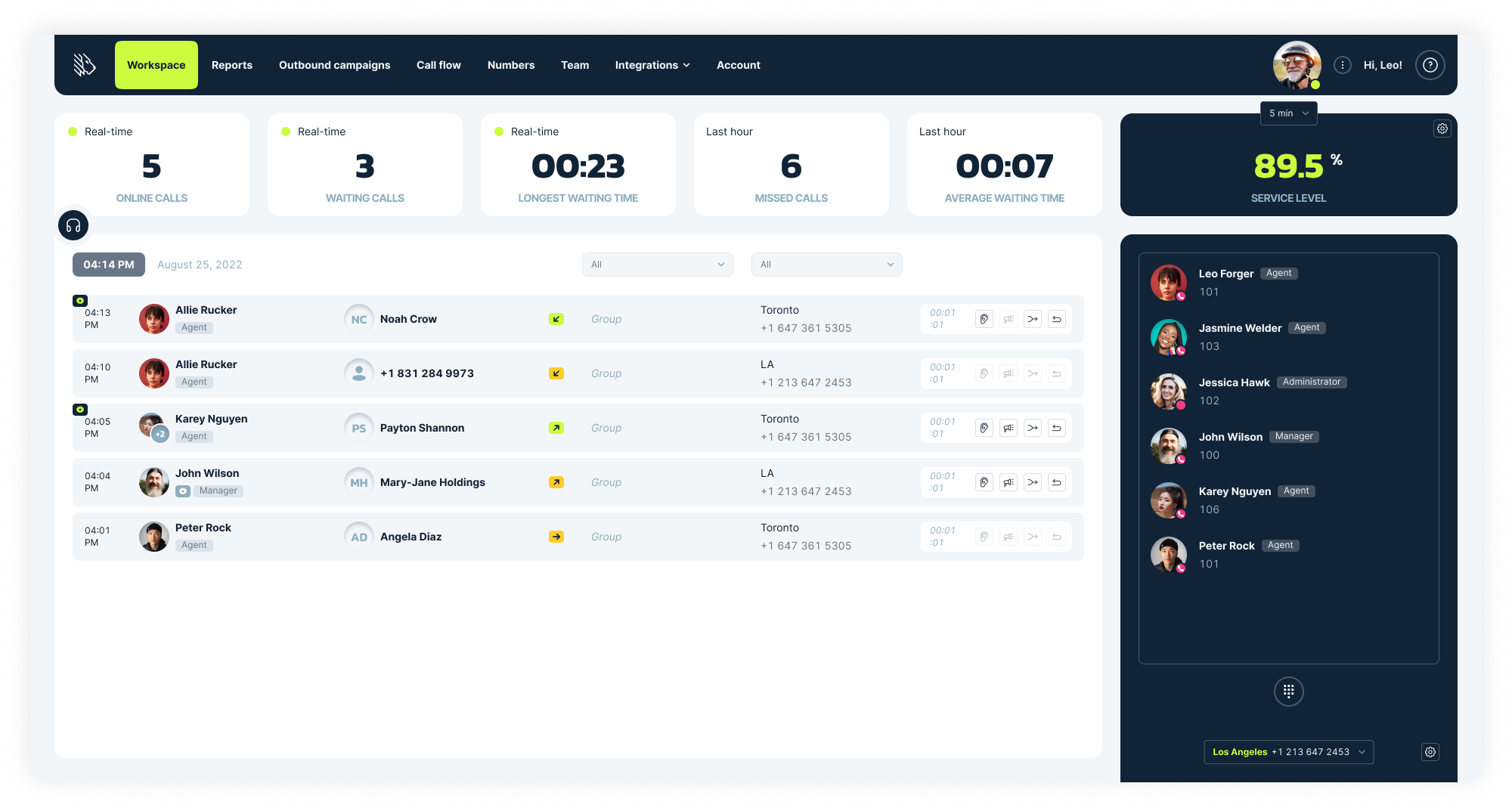Call center metrics are essential tools for measuring the success of your business’s customer support and ensuring that your call center is operating at its peak efficiency. Understanding these metrics and their significance is critical for your business to thrive. In this article, we’ll discuss what metrics mean in a call center, explore the top call center metrics and KPIs, and delve into the industry standards for call center metrics.
What do metrics mean in a call center?
Call center metrics are quantifiable measures that help businesses gauge the effectiveness of their customer support, assess employee performance, and identify areas for improvement. They provide valuable insights into a call center’s overall performance and can be used to make data-driven decisions to enhance customer satisfaction and increase revenue.
Call center metrics spheres
Metrics in a call center context typically encompass several key areas, including:
Customer satisfaction
Measures how happy your customers are with your support services, and can be assessed through surveys or other feedback mechanisms.
Agent performance
Evaluates the efficiency and effectiveness of your customer support agents, based on factors such as call resolution time, first-call resolution rate, and customer feedback.
Operational efficiency
Assesses the overall performance of your call center, considering factors like call volume, average wait times, and staffing levels.
By monitoring these metrics, businesses can identify areas where their call center may be falling short and implement targeted improvements to enhance customer satisfaction and drive business growth. Now, let’s look at MightyCall’s arsenal of call center metrics and their practical use and application.
Why are call center KPIs and metrics important?
Call center KPIs and metrics are essential for multiple reasons:
Performance evaluation
With all the metric numbers in hand, managers can assess the efficiency of call center operations. Having a full picture allows them to fill in the gaps and get rid of any obstacles.
Informed decision making
Metrics help you avoid random decisions related to resource allocation, process improvements, and customer experience enhancements. By looking at the KPIs and metrics, you know exactly what needs to be done.
Goal setting and monitoring
KPIs help set targets, track progress, and ensure alignment with organizational objectives. They help call center agents have measurable milestones to achieve, which will help their discipline and motivation.
Agent performance management
Metrics make it clear who are the top-performing agents, areas of improvement, and training needs. Pay attention to both sides of the matter: what was good, to set as an example, and what was bad, to offer some adjustments.
Customer experience enhancement
This is the end goal of the whole metric system management. By tracking relevant metrics, call centers can identify pain points and take corrective actions to improve customer satisfaction.
Top MightyCall call center metrics and KPIs
Even though MightyCall is constantly expanding the list of metrics, the service already has the most impactful ones at its disposal:
Real-time online calls
The real-time online calls metric provides an instantaneous snapshot of the number of active calls happening within a call center at any given moment. It offers valuable insight into the real-time performance of a call center, ensuring that resources are efficiently managed and customer needs are effectively addressed.
By closely monitoring real-time online calls, call centers can swiftly identify peak hours, potential bottlenecks allowing call center supervisors and managers to make informed decisions on staffing, agent allocation, and overall call center operations. The industry standard for real-time online calls varies depending on factors such as call center size, industry, and service offering.
Real-time waiting calls
Real-time waiting calls is a crucial call center metric that refers to the number of incoming calls currently in queue awaiting an agent’s response. The usefulness of real-time waiting calls lies in its ability to pinpoint possible constraints, helping call centers allocate resources effectively and reduce hold times.
Industry standards for real-time waiting calls also vary depending on many factors. However, an ideal goal is to maintain a low number of waiting calls, ensuring that customers’ concerns are addressed promptly. Tracking this metric and comparing it against established standards will help you optimize workflows.
Missed calls
This metric is measured by calls within the last hour, including those calls where a caller left a voicemail. Dropped calls, which are calls that lasted less than 4 seconds and were disconnected, are not included here. A high rate of missed calls can mean your call center didn’t meet the callers’ expectations and can lead to poor customer satisfaction.
Go deeper and let your supervisors analyze the core reason for the missed calls. Once they do it, it will become clear what needs to be done to minimize missed calls: edit your call flow, change the recorded message that your callers hear or increase your staff.
Average Waiting Time (AWT)
AWT is the average response time including all agents in all call actions over the last hour. The waiting time is calculated from the moment the call is placed in the waiting queue until an agent answers, updating every 5-10 seconds.
For example, let’s say there have been 3 calls over the last 60 minutes. In the first call, the user spent a total of 3 minutes waiting for an agent’s response. In the second call, a total of 5 minutes. In the third – 1 minute. The Average Waiting Time in this case is 3 minutes.
Similarly to the previous metrics, the knowledge of Average Waiting Time can help a call center strategize and lower the number of minutes and even seconds that customers have to wait for an answer.
As a rule, more than 50% of customers expect to hear an answer within 2 minutes. If this doesn’t happen, it’s likely you’ll end up with an unhappy customer.
Longest waiting time
If there’re 5 people waiting for an answer, it will show you how long the first person to get on this line has been waiting for. This metric is updated in real time and offers a clear perspective on the call center’s performance during peak times or when resources are limited.
The usefulness of tracking the longest waiting time lies in its ability to identify instances when customers may experience undue delays, enabling call centers to make necessary adjustments and optimize resource allocation to prevent such occurrences in the future.
The standard is clear – the shorter, the better. An ideal benchmark is to keep the longest waiting time as low as possible, aiming for a maximum duration of around 2-3 minutes.
Service level
Service level is a vital call center metric that measures the percentage of incoming calls that are answered within a predetermined time frame, reflecting the call center’s ability to meet customer expectations. It contains 2 main measurements:
- Number of answered calls within the service level threshold set by you. The standard threshold is 20-30 seconds, but you can set your own standard.
- Total number of calls that your line has received. It includes both answered calls exceeding the time threshold and unanswered calls.

Service Level is one of the key metrics, so it’s important to be able to see it drawn for different time periods. In MightyCall you can adjust the time period to the last 5, 15, 30 and 60 minutes.
As for the standards, what’s been found to be effective is to aim for a service level of 80/20, which means that 80% of the calls should be answered within 20 seconds. If your call center capacity can achieve that – congratulations! You’re on the right path to ideal customer service.
Average Handle Time (AHT)
AHT – is the average amount of time an agent spends handling a call. In MightyCall, this metric is calculated by adding up the time an agent spends speaking with a customer (talk time), the time a caller spends on hold (hold time), and the time an agent spends on post-call activities like documentation or follow-up (wrap-up time), and then dividing it by the number of inbound calls handled.

AHT is a valuable metric because it provides insight into the efficiency of call center operations and can help identify areas for improvement. The industry standards for AHT vary depending on the type of call center, but in general, 6 minutes per call AHT is considered to be the norm and the lower AHT is the better the call center’s performance is.
If Average Handle Time is maintained, it will give a lot of insights. For instance, high AHT can point at the inefficiency of coaching methods in the call center, a gap in some agents’ performance or an inappropriately built call flow. Overseeing the AHT and keeping it within your benchmark will improve workforce management and customer experience.
First Call Resolution (FCR)
FCR shows the percentage of calls when the call center was able to handle the caller’s request in one call. It emphasizes the importance of effectively addressing a customer’s needs in the first call, thereby eliminating the need for follow-up calls or transfers to other agents.
A target range of 70-75% for First Call Resolution is generally considered a good benchmark. By aiming to achieve or surpass these FCR standards, call centers can ensure that their outbound campaigns are consistently driving positive outcomes and fostering strong customer relationships.
First-call resolution is a great KPI that you can use to track your agents’ progress and set measurable goals for them to achieve.
Answered calls
This metric represents the total number of calls in which an agent successfully responds to a prospect or customer, excluding missed calls or calls which ended up in voicemail. Analyzing the total number of answered calls can provide valuable insights into the efficiency and effectiveness of your call center’s outreach efforts. The higher this number, the better customer satisfaction the call center is delivering. It’s also a sign of good resource management and agent performance.
Average Talk Time (ATT)
Average call duration is calculated for the last 60 minutes. Unlike the average Handle Time, this metric does not include time spent on hold (switching to on hold and/or call transfer hold).
Let’s say within the last 60-minute period there have been 3 connected conversations. They lasted for 1 minute, 2 minutes, and 40 seconds. During the second conversation, the agent put the customer on hold for 1 minute. The formula would be (60+(120-60)+40)/3 = 0.8 minutes (53 seconds).

Agent declined
This indicator is related to outbound campaigns during which an agent can take time to get familiar with the request and then make a call being fully equipped about the issue. If the agent decides not to make the call and skips the request, this is when this metric gets +1. The skipped request gets redirected and the agent gets another task.
This metric helps call centers ensure that calls are directed to better suited specialists and allows them to monitor agents with high numbers of skipped requests to determine the underlying cause.
Connection rate
The percentage of the successfully connected calls to the total number of attempted ones. A higher Connection rate signifies that the majority of customers are connected to a live agent promptly, minimizing the likelihood of frustration and abandoned calls.
The industry-standard benchmark for a healthy Connection rate is typically between 80-90%, although this may vary depending on the nature of the business and its specific requirements. If a call center meets the standards, it means the database is open to contact and they pick up calls willingly.
Total number of requests
Total number of requests in outbound call center campaigns refers to the cumulative count of calls that agents should make. This metric is essential for understanding the scale and effectiveness of an organization’s outbound marketing efforts, as well as for optimizing resource allocation and campaign planning.
Contact abandoned
The number of calls that were not connected to an agent and were dropped by the caller. Abandoned calls are a widespread issue in the customer service industry, often resulting from high call volumes, long wait times, or insufficient staffing. These occur when customers, frustrated by the inability to connect with a representative in a timely manner, decide to hang up before their call is answered.
In MightyCall, you’ll also see the metric of abandoned call rate which shows the percentage of dropped calls (abandoned calls / inbound calls) and average abandoned time which is the waiting time before the callee drops the call. (abandoned time / abandoned calls)
Coming soon…
The MightyCall team is constantly working on introducing new features to the service. Take a sneak peek at what will be available in the near future!
Maximum talk time
Maximum call duration between people on the phone for a certain period of time. For example, in the last hour, the business number has received 3 calls, with conversation durations of 1 minute, 4 minutes, and 30 minutes. In this case, the maximum call duration number would show a value of 30 minutes.
If time passes and another call comes in within the next 60 minutes that’s longer, for example, 31 minutes, the value is updated to 31 minutes.
Number of handled requests
The number of requests that have been addressed and resolved by a call center agent. For example, a call center’s outbound campaign has 5000 total requests and your agents were able to handle 1400 of them during the first week. 1400 is the metric indicator in this case. Note that agents can change the status from “handled” to “call back later” and in this case the call will not be included in this metric.
Number of calls in dialing stage
The Number of requests in the dialing stage is a crucial metric that represents the volume of calls that are currently being initiated by agents in an attempt to reach prospective customers or clients. By keeping a close eye on this number, managers can ensure that agents are not spending excessive amounts of time attempting to establish connections with unresponsive numbers or encountering other dialing issues.
Agent workspace metrics
The agent workspace in MightyCall has all the metrics they would need. In their personal setup, agents will see the following sections:
- Average Handle Time / AHT
- Total number of calls handled by agent
- Number of Missed Calls
The agents can monitor these metrics in real time and self-evaluate their work. In addition, if a call center has certain KPIs that agents are obliged to meet, the MightyCall agent workspace will be a good landmark for them to follow and to know if they’re currently doing well or if they have to step it up.
What are the industry standards of metrics and KPIs in call centers?
While specific metrics may vary depending on the industry and call center objectives, some common industry standards include:
Average Waiting Time (AWT)
As a rule, more than 50% of customers expect to hear an answer within 2 minutes. If this doesn’t happen, it’s likely you’ll end up with an unhappy customer.
Service level
As for the standards, what’s been found to be effective is to aim for a service level of 80/20, which means that 80% of the calls should be answered within 20 seconds. If your call center capacity can achieve that – congratulations! You’re on the right path to ideal customer service.
Average Handle Time (AHT)
The industry standards for AHT vary depending on the type of call center, but in general, 6 minutes per call AHT is considered to be the norm and the lower AHT is the better the call center’s performance is.
First Call Resolution (FCR)
A target range of 70-75% for First Call Resolution is generally considered a good benchmark. By aiming to achieve or surpass these FCR standards, call centers can ensure that their outbound campaigns are consistently driving positive outcomes and fostering strong customer relationships.
Answer Success Rate (ASR)
The industry-standard benchmark for a healthy ASR is typically between 80-90%, although this may vary depending on the nature of the business and its specific requirements. If a call center meets the standards, it means the database is open to contact and they pick up calls willingly.
Center metrics: best practices
To effectively leverage call center metrics and drive performance improvement, consider the following best practices:
- Select metrics relevant to your goals: Identify metrics related to your call center’s objectives and prioritize those that have a direct impact on customer experience and team efficiency.
- Establish clear targets: Show your staff what your call center is aiming at, considering industry standards, business objectives, and customer expectations.
- Regularly monitor and analyze metrics: Regularly track and analyze call center metrics to identify trends, patterns, and areas for improvement. Use reporting and analytics to get more insights.
- Provide regular feedback and coaching: Use metrics reports to provide agents with performance feedback and coaching focus to enhance their skills and address any performance gaps.
- Foster a data-driven culture: Encourage a data-driven approach within the call center by implementing the use of metrics in decision-making, process improvements, and goal-setting.
What are the most important call center metrics?
It can be overwhelming to see the abundance of call center metrics, but let us stay focused on what matters the most and highlight the most indicators.
- First Call Resolution (FCR)
- Average Handle Time (AHT)
- Service Level
- Average Waiting Time (AWT)
These metrics allow you to assess the effectiveness of your call center operations and your agents’ performance. Tracking these metrics allows businesses to swiftly determine and resolve issues, enhance the customer experience, and ensure that the operation is cost-effective. On top of that, with remote work taking the lead, these metrics can provide invaluable insights into the performance of agents outside the traditional call center environment, ensuring that the service level remains consistent regardless of where agents are located.
Boost productivity by monitoring KPIs in your call center
Remember to regularly monitor and assess your call center’s performance against industry standards and make adjustments as needed. Investing in your call center’s success by focusing on key metrics and KPIs will not only improve customer satisfaction, but also contribute to the overall growth and success of your business.
At MightyCall, we understand the importance of call center metrics and are dedicated to helping your business thrive. With our advanced virtual phone system, you’ll have access to a wealth of call center metrics to inform your decision-making and optimize your customer support services. Contact us today to learn more about how MightyCall can empower your business to excel in the competitive landscape of customer support.





























